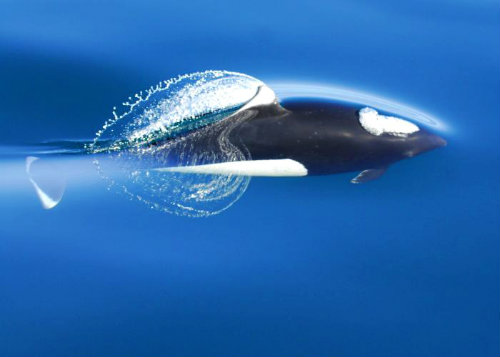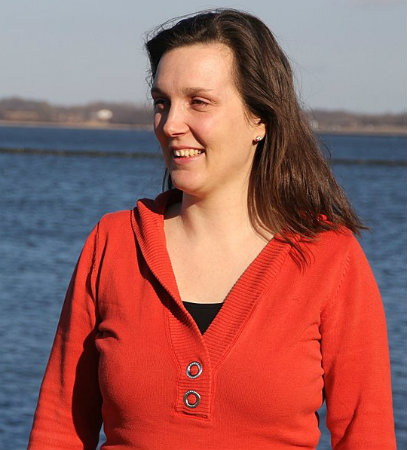Marine wind turbine construction harms porpoises’ hearing & survival (Germany)
Mar 9, 2013

“Wind park building noise ‘can kill porpoises’”
—Unsigned article, The Local: German’s News in English 2/26/13
German scientists are working to prevent the noise from building oceanic wind parks from damaging the hearing of whales and dolphins, after it emerged that the noise could be deadly for sea mammals.

Anja Gallus, from the German Oceanic Museum in Stralsund, said the noise created by hydraulic hammers used to ram the steel base pipes into the sea bed, could kill in particular porpoises in the area. (Editors note: You may contact Ms. Gallus at anja.gallus@meeresmuseum.de.)
“Damage to hearing means the loss of their navigation and thus the possibility of hunting. If the hearing damage remains, the animals mostly die,” she told Die Zeit weekly newspaper.
Porpoises navigate, hunt and communicate with each other with echolocation, making clicks and other noises and hearing the reflection of the noises off objects such as fish, to create an understanding of what is around them.
But the level of noise created by underwater building sites needed to set up the wind parks drown out these subtle noises. Each wind turbine requires an 800-tonne steel base which must be fixed 30 metres deep into the sea bed – and is simply hit with a huge hammer to ram it in.

“The construction work is very noise intensive,” [Professor] Otto von Estorff, from the Technical University Hamburg-Harburg told the paper. “The particularly conductive quality of the water means the noise can be clearly heard for several kilometres.” (Editor’s note: You can reach Prof. Estorff at estorff@tu-harburg.de.)
He and his research team have measured around 200 decibels at the construction site – and it remains at around 180 decibels within 750 metres of the work.
“The maximum noise levels as prescribed by the Federal Maritime and Hydrographic Agency for underwater are at 160 decibels – which is about the noise level of an Oktoberfest band on land. The average noise level around the German coasts is around 90 decibels,” von Estorff said.
The most effective way to keep the noise at site is to create a bubble curtain around the work which acts insulation against the sound waves in the water – effectively breaking them up so they do not travel so well.
The bubble curtain – created by laying a pipe with holes in it on the ground around the foundation work and pumping air through it – can be badly affected by heavy seas though, as strong currents can simply whip the bubbles away, leaving no noise barrier.
Von Estorff and his team are working to try to evaluate other possible methods of reducing the noise pollution from the construction, Die Zeit said. Delays due to adverse conditions preventing the bubble curtains working can easily cost €90,000 for each wind turbine, but there is not yet any other way, said Cay Grunau, from Hydrotechnik Lübeck, a firm which lays the bubble curtain pipes.
“If we are deciding upon environmentally friendly energy, we also have to protect the environment with the building measures necessary. Anything else would be a big contradiction.”

Comment by Marshall Rosenthal on 03/09/2013 at 9:49 am
When the Tappan Zee Bridge was first built across the Hudson River in New York State, USA, a rash of WTS-like illness was reported. This was MOST likely caused by the ILFNs (infrasound and low frequency noise) propagated by the pile drivers used to put in the anchoring-support structure. The same will happen again as they build the Tappan Zee II.
Now we are told that magnificent cetacean life will be destroyed for the sake of the marine windzilla abominations.
This is beyond what decent folk should be saddled with!
Comment by Marco Bernardi on 03/09/2013 at 12:41 pm
“… could kill in particular porpoises in the area…” is wrong! “Do kill” is right!
After starting the projects in the North Sea and Baltic Sea, hundreds of dead propoises were washed ashore. They were starved. Their sonar was destroyed. The reason was the pile driving for Alpha Ventus & Co.
For more information (in German, though you can use Google Translate) click here.
Comment by Anonymous on 03/09/2013 at 1:03 pm
It seems to me that another obvious factor is being overlooked. Low frequency noise (LFN) travels and magnifies underwater and across water. Even after these installations are complete, the LFN and vibrations will affect the sonar of sea mammals.
If they manage to escape the sound that confuses and disorients them, how far must they travel to avoid entering the “sound shadow” of these machines of torture again?
Now, could someone please explain what we hope to gain from all this misery on land and sea?
Comment by mark duchamp on 03/09/2013 at 2:15 pm
And during 20 years, the turbines will be emiting vibrations into the ground, low frequency sound into the water, affecting marine life for miles around them.
We have no idea of the long-term consequences of what we are doing. The “precautionary principle” has been sold to the wind lobby in exchange for contributions to electoral funds.
Comment by Pauline on 03/09/2013 at 11:57 pm
Semantics: WIND FARMS on land and now they are being termed WIND PARKS on the seas!
Well, Mr. Rosenthal’s … WINDZILLAS is the only appropriate terminology!
…… OY VEY!!!!!
Comment by sue Hobart on 05/29/2013 at 9:39 pm
I am truly astonished that the Cape Wind project is still going forward here in Massachusetts.
I am one of the Falmouth turbine refugees already… we have been driven to the brink and fought and lost our tights with only 3 turbines in the mis… and this is all over our state… onsie and twosie land based tirbines wreaking havoc…
Yet… Off cape cod in the beautiful pristine WILL be a huge wind farm in the next few years. It seems unstoppable.
And on the same day these turbines get the thumbs up the governor braggs about the recovery of the seriously endangered right whale in the same waters. This population has finally managed to breed and the count is up from a only a few hundered left in the world.
There is no reality… I am ever amazed ant the lack of any kind of respect for the natural world whatsoever within the government powers. And the freaking Sierria club loves wind.
Face it folks…NOBODY is thinking very hard about anything… We are all lambs to the slaughter at this point.